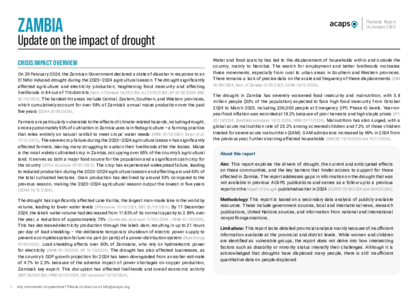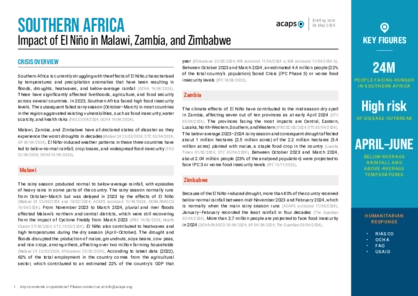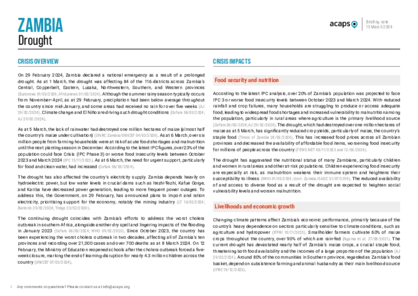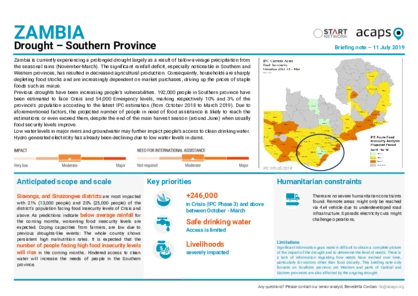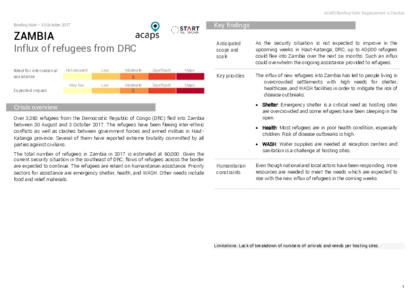Latest updates on country situation
15 October 2024
From October 2024 to March 2025, an estimated 5.8 million people (33% of the analysed population) will likely experience intense food insecurity, including 236,000 facing Emergency (IPC Phase 4) levels. The projected total number of food-insecure people is 65% higher than in the same period during the previous year. The drivers of this increase are shocks and hazards, such as prolonged dry spells between December 2023 and March 2024 leading to El Niño-induced droughts, pests and diseases, human-wildlife conflict, and increased costs. Earlier in February 2024, the country declared a state of disaster as a result of drought. The affected populations urgently require food and livelihood assistance. (IPC 02/10/2024, IPC 13/11/2023, AJ 29/02/2024)
24 September 2024
In 2024, southern Africa is experiencing its worst drought in 100 years as a result of El Niño. Approximately 61 million people need assistance, with over 20 million experiencing Crisis (IPC Phase 3) food insecurity levels. Botswana, Lesotho, Malawi, Namibia, Zambia, and Zimbabwe have declared a state of emergency in response to the severe drought. There has also been a significant increase in malnutrition cases in Angola, Madagascar, Malawi, Mozambique, and Zambia, with expectations for the trend to continue into the first quarter of 2025. (OCHA 20/09/2024, OCHA 19/09/2024)
25 June 2024
In 84 of the 116 drought-affected districts of Zambia, nearly 52,000 children under five are expected to suffer from severe malnutrition over the next 12 months. About 276,000 others are anticipated to experience moderate malnutrition during the same period. In 2024, 9.8 million people in the country are in need, with 6.6 million being food-insecure and approximately 525,000 having nutritional needs. Until the end of 2023, Zambia had one of the highest malnutrition rates globally, with micronutrient deficiencies at 31%. The global acute malnutrition rate was at 4.2%, slightly below the WHO-recommended limit of less than 5%. Those affected require food and nutrition assistance. (UNICEF 21/06/2024, SADC 05/06/2024, WFP 02/04/2024)
05 March 2024
On 29 February 2024, Zambia's President Hakainde Hichilema declared the current drought a national disaster resulting from the impact of El Niño on the country's 2023–2024 rainy season. About six million people in 84 of the country’s 116 districts in Central, Copperbelt, Eastern, Lusaka, North-Western, Southern, and Western provinces have been affected. (UNICEF 04/03/2024, The Maravi Post 05/03/2024)
01 February 2024
Since its declaration in Lusaka in October 2023, the cholera outbreak in Zambia has escalated into a severe public health emergency. As at 26 January 2024, the outbreak had affected all ten provinces of the country, with 14,900 reported cases and 560 deaths, creating a case fatality rate of 3.8%. (WHO 27/01/2024, BBC 31/01/2024)
10 January 2024
Since January 2023, Zambia has been experiencing a cholera outbreak, with a new outbreak reported in Lusaka in October. As at 11 January 2024, a cumulative 8,276 cases and 333 deaths had been recorded, with Lusaka having 94% of confirmed cases and 97% of deaths. The outbreak has spread to 39 districts in nine of ten provinces. (Zambian MOH 14/12/2023, ECHO 12/01/2024)
13 November 2023
According to IPC projections, food security is expected to worsen between October 2023 and March 2024. Food insecurity is driven by food commodity prices that are expected to remain higher than the five-year average, a decrease in job opportunities, the impacts of the ongoing Ukraine/Russia conflict, and the delayed onset of rains due to the El Niño phenomena. Approximately 2.04 million people (23% of the population assessed) will face acute food insecurity (IPC Phase 3 and above). The number of districts anticipated to face IPC Phase 3 food insecurity is expected to increase to 67 from 45 in the August-September period. The western and southern as well as parts of the eastern provinces are likely to be the most affected due to preexisting food, water, and pasture shortages. Food insecure households require food and cash support, increased access to income, and improved dietary choices.
(IPC 13/11/2023)
current crises
in
Zambia
These crises have been identified through the INFORM Severity Index, a tool for measuring and comparing the severity of humanitarian crises globally.
ZMB002 - Drought
Last updated 24/10/2025
Drivers
Drought/drier conditions
Crisis level
Country
Severity level
3 Medium
Access constraints
1.0
Analysis products
on
Zambia
16 January 2025
Zambia: update on the impact of drought
DOCUMENT / PDF / 772 KB
This report explores the drivers of drought, the current and anticipated effects on these communities, and the key barriers that hinder access to support for those affected in Zambia. The report addresses gaps in information on the drought that was not available in previous ACAPS publications and serves as a follow-up to a previous report on the impact of drought published earlier in 2024
15 March 2024
Zambia: impact of drought
DOCUMENT / PDF / 509 KB
On 29 February 2024, Zambia declared a national emergency as a result of a prolonged drought. As at 1 March, the drought was affecting 84 of the 116 districts across Zambia’s Central, Copperbelt, Eastern, Lusaka, Northwestern, Southern, and Western provinces. Climate change and El Niño are driving such drought conditions.
11 July 2019
Zambia: drought in the Southern province
DOCUMENT / PDF / 493 KB
Zambia is currently experiencing a prolonged drought largely as a result of below-average precipitation from the seasonal rains (November-March). The significant rainfall deficit, especially noticeable in Southern and Western provinces, has resulted in decreased agricultural production. Consequently, households are sharply depleting food stocks and are increasingly dependent on market purchases, driving up the prices of staple foods such as maize.
13 October 2017
Zambia:Influx of refugees from DRC
DOCUMENT / PDF / 307 KB
Over 3,360 refugees from the Democratic Republic of Congo fled into Zambia between 30 August and 3 October 2017. The refugees have been fleeing inter-ethnic conflicts as well as clashes between government forces and armed militias in Haut-Katanga province. Several of them have reported extreme brutality committed by all parties against civilians.


